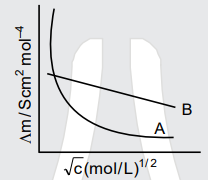Following figure shows dependence of molar conductance of two electrolytes on concentration, ∧mo is the limiting molar conductivity.

The number of incorrect statement(s) from the following is ______
(A) ∧mo for electrolyte A is obtained by extrapolation
(B) For electrolyte B,∧m vs √c graph is a straight line with intercept equal to ∧mo
(C) At infinite dilution, the value of degree of dissociation approaches zero for electrolyte B.
(D) ∧mo for any electrolyte A or B can be calculated using λ∘ for individual ions.
Step by step video solution for Following figure shows dependence of molar conductance of two electrolytes on concentration, wedge m^o is the limiting molar conductivity.The number of incorrect statement(s) from the following is ______(A) wedge m^o for electrolyte A is obtained by extrapolation (B) For electrolyte B, wedge m vs sqrt(c) graph is a straight line with intercept equal to wedge m^o (C) At infinite dilution, the value of degree of dissociation approaches zero for electrolyte B. (D) wedge m^o for any electrolyte A or B can be calculated using lambda^(@) for individual ions. by Chemistry experts to help you in doubts & scoring excellent marks in Class 12 exams.
Updated on:21/07/2023Topper's Solved these Questions
Similar Questions
Knowledge Check
Molar conductance of electrolytic solution ∧m is
A∝1B∝(1/A)C∝(1/C)D∝(√C)The plot of molar conductance vs √C in strong electrolyte , is
AcircularBlinearCparabolicDsinusoidalThe molar conductivity of strong electrolyte
AIncreases on dilution slightlyBDoes not change on dilutionCDecreases on dilutionDDepends on density of electrolyte itself
Write an expression to co-relate molar conductivity of the electroyte to the degree of dissociation.
View SolutionExplain with a graph the variation of molar conductivity of a strong electrolyte with dilution.
View SolutionThe quivalnet conductance of any electrolyte MA at infinite dilution ∧∘.(MA) is equal ( more than one correct answer)
View SolutionThe specific conductance (k) of an electrolyt e of 0.1 N concentration is related to equivalent conductance (∧) by the following formula
View SolutionThe equivalent conductivity of 0.1 M weak acid is 100 times lesser than that at infinite dilution. The degree of dissociation of weak electrolyte at 0.1 M is -
View Solution
